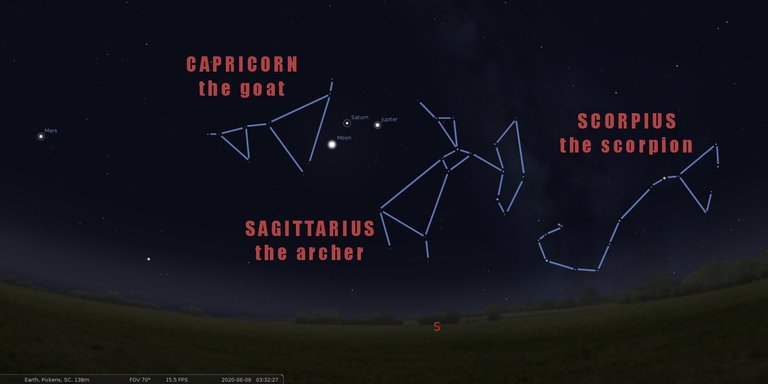Looking South, 08-Jun-2020
If you go outside on the night of 08-Jun-2020, you should be able to see a pretty sight in the sky. When the Moon rises sometime around 12:00 midnight (times will vary slightly, depending where on the Earth you live), you will be able to see two "stars" near the Moon. The brightest of these two is actually the planet Jupiter, and the other one is the planet Saturn.
NOTE: If you are an "early to bed, early to rise" person, the Moon, Jupiter, Saturn, and Mars will still be visible if you awake before sunrise! They will just be in a slightly different location!
If you are in a relatively dark location away from the bright lights of a town or city, you might also enjoy looking for three constellations. You can play "connect the dots" to make stick figures in your imagination as the ancient peoples did (before Netflix!).

screenshot from STELLARIUM ~ click to enlarge!
Scorpius (the Scorpion) is one of the easiest constellations to spot because it looks like a celestial "J" with the pincers of the scorpion on top. The brightest star in the constellation of Scorpius is Antares, whose name translates to "Rival of Mars" because the star is of similar brightness and color to the planet Mars.
Sagittarius (the Archer) is a centaur figure (half-man/half-horse) who is pointing a bow-and-arrow at the scorpion to be sure he behaves!
Capricorn (the Goat) is to the left of the Moon, with its head down, charging forward.
If the bright light of the Moon makes these stick-figures of the constellations too difficult to see, simply go back out on a moonless night and you should be able to find Jupiter and Saturn again, since they're so bright. Then look for the three constellations without the Moon's interference!
If you go outside any time between 2:00 AM and sunrise, you should also be able to see Mars, the Red Planet, shining off to the left of where Capricorn's horn is pointing!

I became interested in the night sky when I was about eight-years-old from a book that I borrowed from the library in my Elementary/Primary School. Most of my life, I've ventured outside every night or two and looked at the stars. I don't do it as often now that I am older and my eyesight isn't as good, but I still try to keep tabs on what's going on up there and look at it when I can!
For much more information about astronomy, see this post I authored two years ago! I think it is worth the read, for those interested in the subject!
And lastly, for those interested in the software I used for the image in this post:
STELLARIUM is a free, open-source, planetarium software that runs on a computer. It is available for Linux, Mac OS-X 10.12+/64-bit, Windows/32-bit, and Windows/64-bit. I have had it on my computers for the past ten years or so, although the original project dates back to 2006. I highly recommend it for anyone who enjoys looking at the night sky! It even comes with a 'Night Vision' mode that will dim the screen so you can take your laptop outdoors without destroying the natural 'Night Vision' that humans gain by being outdoors for a while. There are many settings and modes for various things, so just play with them and see what they do, or press the <F1> key for HELP at any time!
 😊
😊SOURCES
1 Space.com: Night sky, June 2020
2 Stellarium
3 StarDate.org






to learn more about either of these projects, please visit: @heyhaveyamet or @theterminal

08-Jun-2020
